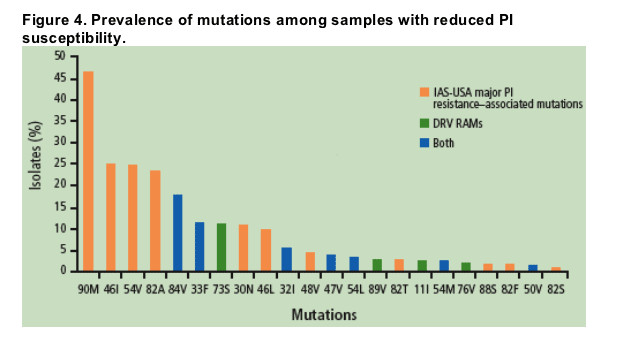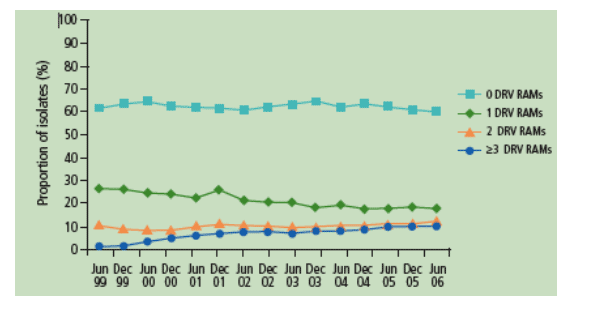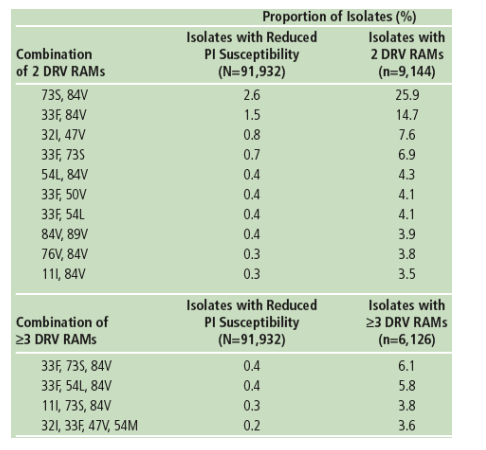 |
 |
 |
| |
Prevalence of Darunavir Resistance-Associated Mutations in Samples Received for Routine Clinical Resistance Testing
|
| |
| |
Reported by Jules Levin
5th European HIV Drug Resistance Workshop (EHDRW 2007),
Cascais, Portugal, March 28-30, 2007
AR Rinehart1; G Picchio2; M-P de Bthune3; LB Bacheler4; T Pattery5; B Wasikowski6; and R Falcon1
1Tibotec Therapeutics, Bridgewater, NJ, USA; 2Tibotec Inc., Yardley, PA, USA; 3Tibotec BVBA, Mechelen, Belgium; 4VircoLab, Inc., Durham, NC, USA; 5Virco BVBA, Mechelen, Belgium; and 6xLeo, Inc., Raleigh, NC, USA
Author Conclusions:
Of 91,932 isolates with evidence of clinically relevant reductions in PI susceptibility submitted for routine clinical resistance testing, 62% had no DRV RAMs.
The co-existence of 3 or more DRV RAMs at baseline was infrequent (6.7%) among isolates with evidence of reduced PI susceptibility.
Overall, 7 of the 11 DRV RAMs occurred at a frequency of <5% in isolates with reduced PI susceptibility.
Our findings are consistent with a recent report of the low prevalence of DRV RAMs in 532 patients who were on failing PI-based regimens. 8
ABSTRACT
Background: In the POWER studies, the number of darunavir (PREZISTAŞ) resistance-associated mutations (DRV RAMs; V11I, V32I, L33F, I47V, I50V, I54L or M, G73S, L76V, I84V, or L89V) at baseline was shown to be a predictor of virologic response to DRV/r 600/100mg bid. Patients whose virus harbored 2 or fewer DRV RAMs had the best virologic response. Viruses that had 3 or more DRV RAMs also had a median of at least 12 IAS-USA protease inhibitor (PI) resistance-associated mutations (IAS-USA October 2006). Here we report the prevalence of each DRV RAM and the frequency of various combinations in a large number of samples with evidence of reduced PI susceptibility received for routine clinical resistance testing.
Methods: Approximately 208,000 samples were submitted to Virco for routine clinical resistance testing between July 1998 and June 2006. Samples were defined as having evidence of reduced PI susceptibility if the predicted fold change in IC50 for any PI was greater than the respective vircoTYPE lower clinical cut-off (CCO1, vircoTYPE v. 4.0.01).
Results: 91,900 (44%) of the 208,000 samples submitted to Virco had evidence of reduced PI susceptibility. The DRV RAMs that occurred most frequently regardless of the presence of other DRV RAMs or PI mutations were I84V (17.8% of samples), G73S (11.7%), L33F (11.2%), and V32I (5.4%). The others were present in less than 5% of samples. The majority (62.4%) of isolates with reduced PI susceptibility contained no DRV RAMs, while 21.0% harbored 1 DRV RAM, 9.9% harbored 2, and 6.7% harbored 3 or more. The most frequently occurring combinations of 2, 3, and 4 DRV RAMs were G73S+I84V (2.6% of samples), L33F+G73S+I84V (0.4%), and V32I+L33F+I47V+I54M (0.2%), respectively. By way of comparison, the most frequently occurring (>20% of samples) IAS-USA major PI resistance-associated mutations were L90M (46.2%), V82A (23.2%), and M46I (22.3%).
Conclusion: Of more than 91,000 clinical isolates with evidence of reduced PI
susceptibility submitted for routine clinical resistance testing, 62% had no DRV RAMs. Overall, 7 of the 11 DRV RAMs occurred at a frequency of <5%. The co-existence of 3 or more DRV RAMs at baseline was infrequent (7%) among samples with evidence of reduced PI susceptibility.
Data in the poster body have been updated since the abstract was originally submitted.
Introduction
• Darunavir (DRV [PREZISTAŞ]) is a protease inhibitor (PI) that has significant in vitro antiretroviral (ARV) activity against both wild-type virus and multidrug resistant HIV-1 strains1
• DRV co-administered with low-dose ritonavir (DRV/r) has been approved in the United States, Canada, Russia, Argentina, Switzerland, Australia and the European Union2 for the treatment of HIV infection in ARV treatment-experienced adult patients at a recommended dose of 600/100mg bid
• In the POWER 1 and 2 studies and the POWER 3 analysis,3 the number of DRV resistance-associated mutations (RAMs) at baseline was a strong predictor of virologic response to DRV/r 600/100mg bid
• We report the prevalence of DRV RAMs in a large number of isolates with evidence of reduced PI susceptibility received at Virco for routine clinical testing.
Methods
• Analysis was conducted in October 2006 on samples submitted for routine clinical resistance testing between July 1998 and June 2006. Samples from research studies and clinical trials were excluded from this analysis
• Samples were defined as having evidence of reduced PI susceptibility by:

- A biological cutoff of 2.4 was used for analysis of susceptibility to atazanavir. This has recently been superceded by clinical cutoffs using the vircoTYPE HIV 1 resistance analysis for atazanavir/r 5
• DRV RAMs6 were defined as:
- V11I, V32I, L33F, I47V, I50V, I54L or M, G73S, L76V, I84V, or L89V
• IAS-USA PI resistance-associated mutations7 were defined as:
- L10C/F/I/R/V, V11I, K20I/L/M/R/T/V, L24I, D30N, V32I, L33F/I, E34Q, M36I/L/V, M46I/L, I47A/V, G48V, I50L/V, F53L/Y, I54A/L/M/S/T/V, I64L/M/V, A71V/T, G73A/C/S/T, L76V, V77I, V82A/F/I/L/S/T, I84A/C/V, N88D/S, L89V, L90M, I93M
Because the definition of reduced PI susceptibility was based on Virco clinical cutoffs established from clinical outcomes data, the reduced susceptibility of isolates to PIs is expected to be clinically relevant.
RESULTS
207,910 sequences of samples submitted to Virco for routine clinical resistance testing between July 1998 and June 2006 were analyzed; 91, 932 isolates with evidence of clinically relevant reductions in PI susceptibility.
Evidence of reduced PI susceptibility among isolates submitted to Virco for routine testing has been declining over time since 1999, perhaps due to increased rates of resistance testing in treatment-nave patients, from 61% in 1999 to 36% in June 2006.
The majority (62.4%) of isolates with evidence of reduced PI susceptibility contained no DRV RAMs, while 21.0% harbored 1 DRV RAM, 9.9% harbored 2, and 6.7% harbored 3 or more.
Among isolates with evidence of reduced PI susceptibility, the DRV RAMs that occurred most frequently regardless of the presence of other DRV RAMs or PI mutations were I84V (17.8% of samples), G73S (11.1%), L33F (11.2%), and V32I (5.4%).
The prevalence of individual DRV RAMs and IAS-USA major PI resistance-associated mutations are shown in Figure 4.

Among isolates with evidence of reduced PI susceptibility, the prevalence of most IAS-USA major PI resistance-associated mutations has remained fairly constant over time, with the exception of a noticeable increase in 33F and a decline in 90M. Similarly, 33F was the only DRV RAM to change noticeably over time (data not shown)
Figure 5 shows changes over time in the proportion of isolates with reduced PI susceptibility harboring 0, 1, 2, or 33 DRV RAMs.
Figure 5. Time trends in the proportion of isolates with reduced
PI susceptibility harboring 0 to >/=3 DRV RAMs.
Total number of isolates with reduced PI susceptibility = 91,932.

Table 1 lists the most common combinations of DRV RAMs, reported as a percentage of all isolates with reduced PI susceptibility, and only those isolates that had >/=2 DRV RAMs.
Table 1. Most common combinations of DRV RAMs* among isolates with reduced PI susceptibility
*Occurring in 33% of 91,932 isolates.
Total proportion of isolates with 2 DRV RAMS = 9.9%; total proportion of isolates with 33 DRV RAMS = 6.7%.

REFERENCES
1. De Meyer S, et al. Antimicrob Agents Chemother 2005;49:2314-21.
2. EMEA approved product information website: http://www.emea. eu.int/humandocs/Humans/EPAR/prezista/prezista.htm
3. Cohen C, et al. 44th Annual Meeting of the Infectious Diseases Society of America, October 12-15, 2006, Toronto, Canada. Oral Presentation 688.
4. Staes M. XV International HIV Drug Resistance Workshop, June 13-17, 2006. Poster 28.
5. Winters B, et al. 14th Conference on Retroviruses and Opportunistic Infections, February 5-28, 2007, Los Angeles, California. Poster 611.
6. De Meyer S, et al. XV International HIV Drug Resistance Workshop, June 13 17, 2006. Oral Presentation and Poster 73.
7. Johnson VA, et al. Top HIV Med 2006;14:125-31.
8. Loveday C, et al. Eighth Congress on Drug Therapy in HIV Infection, November 12-16, 2006, Glasgow, UK. Abstract PL2-2.
|
| |
|
 |
 |
|
|